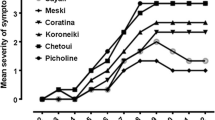Abstract
Susceptibility to the insectBactrocera oleae and the fungiSpilocaea oleagina andSphaeropsis dalmatica was investigated in four olive cultivars, two for table fruit production (Kalamon and Chondrolia Chalkidikis) and two for oil production (Lianolia and Koroneiki). Cv. Chondrolia Chalkidikis was the most susceptible to all three pathogens, followed by cv. Kalamon. Soil plowing and the organic fertilizer Bio-Trust® (10-3-6+8% MgCO3+10% CaCO8) increased the susceptibility of all four tested olive cultivars to the insect and the two fungi. Correlations were found between the attacks byB. oleae and infections byS. oleagina andS. dalmatica on the four olive cultivars.
Similar content being viewed by others
References
Ahmed, S.A. and El-Bassiouny, M.N. (2002) Spatial distribution of olive fruit flyBactrocera (Dacus) oleae (Gmelin) on olive varieties in North Sinai.Ann. Agric. Sci. Moshtohor 40:541–547.
Anon. (1986) Hojiblanca. Gordal Sevillana.Olivae 3:34–35.
Anon. (1999) Bouteillan.Arboric. Fruit. 533:71.
Boco, M., Pilli, M. and Tombesi, A. (2002) First evaluation of pruning intensities and intervals in olive.Riv. Fruttic Ortofloric. 64:71–75 (Italian, with English summary).
Dimou, I., Koutsikopoulos, C., Economopoulos, A.P. and Lykakis, J. (2003) Depth of putation of the wild olive fruit fly,Bactrocera (Dacus) oleae (Gmel.) (Dipt. Tephritidae), as affected by soil abiotic factors.J. Appl. Entomol. 127:12–17.
El-Bassiouny, M.N., Negm, F.H. and Salem, M.M. (1996) Susceptibility of the olive varieties for the infestation byDacus oleae (G) as related to their physical and chemical properties.Ann. Agric. Sci. Moshtohor 34:1935–1942.
Greca, L. and Vrenna, G. (1995) Damage bySphaeropsis dalmatica in Calabria.Inf. Fitopatol. 45:32–33.
Gümusay, B., Özilbey, U., Ertem, G. and Oktar, A. (1990) Studies on the susceptibility of some important table and oil olive cultivars of the Aegean region to olive fly (Dacus oleae Gmel.) in Turkey.Acta Hortic. 286:359–362.
Iannotta, N. (1999) Susceptibility of diverse olive cultivars to olive fly and peacock spot.Inf. Agrario 55: 48, 69–73 (Italian; English summary in CAB Abstracts Database #20001608820).
López-Doncel, L.M., Trapero, A. and Garcia-Berenguer, A. (1999) Resistance of olive tree cultivars to leaf spot caused bySpilocaea oleagina.Acta Hortic. 474:549–554.
Michelakis, S. (1990) The influence of pests and diseases on the quantity and quality of olive oil production.Olive 67:38–40.
Proietti, P. and Famiani, F. (2005) Cultural choices and olive health.Inf. Fitopatol. 55:4–11.
Zachos, D.G. and Tzavella-Klonari, K. (1979) Research on the identity and systematic position of the fingus causing the olive disease attributed toMacrophoma orSphaeropsis dalmatica.Ann. Inst. Phytopathol. Benaki 12:59–71.
Author information
Authors and Affiliations
Corresponding author
Rights and permissions
About this article
Cite this article
Navrozidis, E., Zartaloudis, Z., Thomidis, T. et al. Effect of Soil Plowing and Fertilization on the Susceptibility of Four Olive Cultivars to the InsectBactrocera oleae and the FungiSphaeropsis dalmatica andSpilocaea oleagina . Phytoparasitica 35, 429–432 (2007). https://doi.org/10.1007/BF03020599
Received:
Accepted:
Issue Date:
DOI: https://doi.org/10.1007/BF03020599




